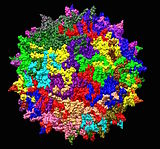Portal:Viruses/Selected virus/15
Adeno-associated viruses (AAVs) are two small DNA viruses in the Dependoparvovirus genus of the Parvoviridae family. They cannot complete their lytic replication cycle without a helper virus, which include adenoviruses, herpesviruses and vaccinia. In the absence of the helper, AAVs can integrate into the host genome at a specific site on human chromosome 19, or persist as an episome. The 20 nm icosahedral capsid lacks an envelope, and contains a single-stranded DNA genome of around 4.7 kb. AAVs infect humans and some other primates without causing disease. They generate only a mild immune response, including neutralising antibodies. The best-studied of the 11 serotypes, AAV-2, infects nerve cells, liver cells, skeletal muscle and vascular smooth muscle, using heparan sulphate proteoglycan as its primary receptor.
Its low pathogenicity makes AAV an attractive basis for viral vectors for gene therapy. Alipogene tiparvovec to treat lipoprotein lipase deficiency was the first gene therapy to be licensed, but was later withdrawn. Promising results have been obtained in early clinical trials with AAV-based gene therapy in haemophilia, congestive heart failure, spinal muscular atrophy, Parkinson's disease and the rare eye disease Leber congenital amaurosis.
